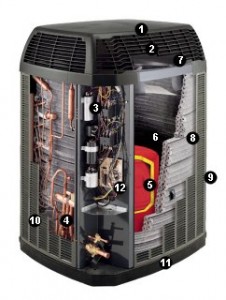Air Conditioning Efficiency – Are Attic HVAC Systems Efficient?
 The Value Of Air Conditioning Your Attic
The Value Of Air Conditioning Your Attic
In a recent report concerning home air conditioning efficiency, the U.S. Department of Energy challenged the wisdom of locating HVAC systems in an unconditioned attic (1). So what brings about this challenge to conventional A/C handling methods? Why would anyone want to air condition a space that is not used for personal comfort? If typical U.S. housing construction involves placing the A/C air-handling unit in unconditioned attic space, what benefits can be achieved by flipping the coin?
Well, live and learn.
According to Energy.Gov, placing components of your home HVAC system within the non-vented control of an unconditioned attic can actually increase heating and cooling-related energy consumption by as much as 10%. Several reasons promote this concept. However air loss due to A/C duct leakage may be the major factor. Current research evidences that duct air leakage often exceeds twenty percent of the regulated airflow. And that, my friend, results in a significant and controllable loss of energy.
The evidence is in: Placing your indoor home HVAC components within a non-vented insulated and conditioned attic or crawlspace can provide a substantial reduction in energy expenditure. Although the attic may not be used as home living space, capturing and retaining the loss air flow results in improved home heating and cooling energy performance. However, fully sealing the attic tends to defy traditional house building codes. And we all know that things that defy tradition trigger an automated human resistance to change. So after years of being directed to construct your home with installed attic ventilation, why should we accept this notion of change?
New Understanding of Air Conditioning Efficiency
Perhaps you are unaware of current construction changes as they relate to the air conditioning industry. However thanks to Building America, since 2006 the practice of constructing vent-free fully insulated attics has been an accepted home construction building code. For over twenty years, the U.S. DOE has sponsored the Building America program as a focus for helping study and promote innovation in residential building construction. The introduction of non-vented attics is just one more successful endeavor. The primary purposes of Building America include promotion of:
- More affordable energy
- Greater product reliability
- Enhance product performance
- AND Better home comfort.
Along with other various energy-focused products and home design, Building American partners with world-class HVAC industry and HVAC research leaders to raise the standards in home air conditioning and A/C product performance.
Air Conditioning Efficiency Enhanced By Non-Vented Well-Insulated Attics
Ventilation enables moisture as well as warm air to escape from an attic. When attic-installed A/C equipment is not involved in the equation, vented attics with a well-sealed and insulated ceiling decks prove to be very efficient for helping reduce the cost of home air conditioning. However, if HVAC equipment, including air conditioning ductwork, is installed in the vented attic of an Arizona home, the energy consumption of that home may actually increase.
Yet conditions to exist. If your Arizona air conditioning is installed in a home not purposefully constructed for a non-vented attic, updating to new standards can be costly and difficult. For example: standard home roof structures often include slopes that are inadequate for installing attic-wide top plate installation. Furthermore, the typical home attic includes installed flues, hatches, water piping, electrical wiring, and various difficult-to-work-with knee walls and ceilings. Unless your attic can be completely sealed, some measure of air leakage is unavoidable. The result: an increase demand on your heating and cooling system.
Funds spend to increase Arizona air conditioning efficiency may actually increase your problems. It humid air from your living quarters escapes into a non-vented and conditioned attic space, condensation and moisture against the cold roof sheathing may become a potential calamity of accumulated mold and mildew. On the other side of the scale, if inside warm air seeps into a sealed and conditioned home attic it can heat the roof deck and result in an increased winter risk of ice dams.
In conventional vented attics, installed HVAC components are routinely exposed to the current external temperature extremes – extremes that may well increase due to additional complications related to home attics. Insulating and effectively sealing along the roof line of your home can provide better:
- Energy efficiency and savings
- Increased moisture resistance
- Reduced risk of wood rot and mold
- A more secure storage space
- And better wind resistance as well as increased fire and rain protection for your entire roof.
American Cooling and Heating – Arizona Air Conditioning Efficiency Experts
Maybe you are not certain about the conditions of your attic installed Arizona A/C equipment. Perhaps comfort in the living quarter is not a problem, yet the cost of staying cool seems out of hand. We can help. Call now for your appointment with a bonded, licensed and insured Arizona HVAC professional. The team at American Cooling and Heating is ready to provide 24/7 A/C repair, A/C replacement, and A/C evaluation.
1) Building American, Top Innovations Hall of Frame Profile